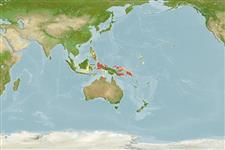>
Blenniiformes (Blennies) >
Blenniidae (Combtooth blennies) > Blenniinae
Etymology: Meiacanthus: Greek, meion = less = lessen + Greek, akantha = thorn (Ref. 45335); crinitus: Specific epithet means 'hairy', referring to the elongate inner caudal-fin rays which distinguish the adult males.
Environment: milieu / climate zone / गहराई सीमा / distribution range
पारिस्थितिकी
समुद्री ड़िमरसल; गहराई सीमा 0 - 20 m (Ref. 90102). Tropical
Western Central Pacific: Indonesia.
आकार / वज़न / Age
परिपक्व अवधि: Lm ? range ? - ? cm
Max length : 10.0 cm TL पुल्लिंग / अलिंग; (Ref. 48636)
Short description
पहचान कुंजी | आकृति विज्ञान | मौरफोमैटरिक्स
Males with long filament extending from one or two rays of the tail (Ref. 48636).
Body shape (shape guide): fusiform / normal.
A shallow water species, forming small aggregations in well protected narrow bays or inlets. Usually in sponge habitats (Ref. 48636). Adults may be found solitary or in pairs (Ref. 90102). Oviparous. Eggs are demersal and adhesive (Ref. 205), and are attached to the substrate via a filamentous, adhesive pad or pedestal (Ref. 94114). Larvae are planktonic, often found in shallow, coastal waters (Ref. 94114). Mimics the young of Pentapodus trivittata (Ref. 90102). Minimum depth of 0 m reported from Ref.7401.
Life cycle and mating behavior
परिपक्व अवधि | पुनरुत्पत्ति | मछलीऔ का अंडे देना | अंडे | Fecundity | लार्वा
Oviparous, distinct pairing (Ref. 205).
Smith-Vaniz, W.F., 1987. The saber-toothed blennies, tribe Nemophini (Pisces: Bleniidae): an update. Proc. Acad. Nat. Sci. Philad. 139:1-52. (Ref. 7401)
IUCN Red List Status (Ref. 130435: Version 2025-1)
Threat to humans
Harmless
Human uses
साधन
Special reports
Download XML
इंटरनेट स्रोत
Estimates based on models
Preferred temperature (संदर्भ
123201): 28.8 - 29.3, mean 29 °C (based on 262 cells).
Phylogenetic diversity index (संदर्भ
82804): PD
50 = 0.5000 [Uniqueness, from 0.5 = low to 2.0 = high].
Bayesian length-weight: a=0.01047 (0.00434 - 0.02525), b=3.07 (2.86 - 3.28), in cm total length, based on LWR estimates for this (Sub)family-body shape (Ref.
93245).
Trophic level (संदर्भ
69278): 3.4 ±0.4 se; based on size and trophs of closest relatives
लौटाव (संदर्भ
120179): ऊंचा, न्यूनतम जनसंख्या दुगनी समय अवलागत 15 महीने। (Preliminary K or Fecundity.).
Fishing Vulnerability (Ref.
59153): Low vulnerability (10 of 100).
🛈
Nutrients (Ref.
124155): Calcium = 350 [212, 841] mg/100g; Iron = 1.86 [1.13, 3.25] mg/100g; Protein = 17.7 [16.7, 18.6] %; Omega3 = 0.23 [0.13, 0.42] g/100g; Selenium = 32.8 [16.2, 73.0] μg/100g; VitaminA = 53.7 [16.9, 170.2] μg/100g; Zinc = 2.07 [1.37, 3.05] mg/100g (wet weight);
